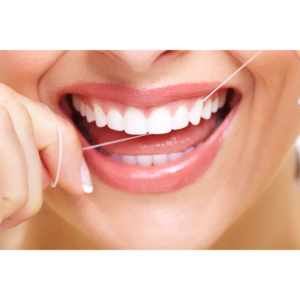String or Water?

In 1962, someone thought that forcing water between your teeth as part of home care might be a good thing. The hope was that pulses of water directed between your teeth would be more likable than using dental floss (which most patients are loath to do daily!) to remove food and plaque buildup. Plaque is a sticky film can accumulate on your teeth and lead to issues like cavities and gum disease. So is a water flosser the best way to prevent that yicky plaque from building up between your teeth?
Just like string floss, a water flosser cleans between your teeth, removing little bits of gunk from your teeth and this is really important. When you allow food to ‘stew’ in your mouth, the resulting plaque releases acids that harm your enamel according to the American Dental Association (ADA). These acids can eventually cause tooth decay and gingivitis, the first stage of gum disease. Most of us brush our teeth (hopefully!) at least twice a day and this certainly helps remove plaque. But brushing, whether it is the use of a manual toothbrush or an ultrasonic/electric toothbrush does not reach between your teeth. Flossing makes sure you reach those in-between areas but studies have found that water flossers are also an option.
A water flosser is a handheld device that shoots a stream of liquid at your teeth hard enough to clean between them, according to the American Dental Association. A water flosser might be good for you depending on your teeth and preferences. “Using a water flosser is like hosing down a deck while traditional flossing is like sweeping it”, says Vera Tang, D.D.S., clinical assistant professor of periodontology and implant dentistry at the NYU College of Dentistry. They both get the job done but in slightly different ways. “Which is better? Whichever one you are more likely to use every day,” according to Edmond R. Hewlett, D.D.S., a professor at the UCLA School of Dentistry. Water flossers that have earned the ADA Seal of Acceptance have been tested to be safe and effective at removing plaque. Just as with floss, experts generally still want you to use a water flosser at least once daily.
So is who is a good candidate for using a water flosser?
- If you absolutely have a mental block or hate flossing so much that you don’t do it at all or it you don’t do it correctly. You’re supposed to insert the floss, then use a C shape to scrape the string down both teeth, one after the other. You’re also supposed to floss the back sides of your last teeth, FYI. If you’d rather have a mammogram or a prostate checkup than follow these steps, a water flosser might be better for you.
- If you have fixed bridges or orthodontic work that makes it difficult to use regular string floss, then the water flosser may help you a lot.
- Your teeth are crowded, overlapped or aren’t super straight or if you have trouble running floss back and forth between them, a water flosser could make your life easier.
- Water flossers are helpful for people with dexterity issues, such as arthritis, who find string flossing difficult.
Price is something to keep in mind when making your decision about water flossers. The options on the ADA’s list of water flossers with the organization’s seal of acceptance start around $40, but some water flossers are over $100. That’s pretty pricey but the devices are supposed to last for years, so that could actually be cost-effective. Important! If you decide to get a water flosser, don’t throw away your string floss. A water flosser may not do the job if something is really stuck between your teeth. Also, neither string floss or a water flosser will remove the hard, calcified tartar/calculus once that accumulates…you will need to see our hygienists Claire or Ann for that!
Whether it’s traditional string floss or a water flosser, cleaning between your teeth once a day is an important part of your dental hygiene routine. You should also brush your teeth twice a day for two minutes and see your Smile Sarasota team regularly. We will be posting a future blog about another newer option for cleaning between your teeth…the Air Flosser! Stay tuned!
Click here for a short video about using a water flosser
Sources and Credits: American Dental Association, Self.com, Mouthhealthy.org, Verywellhealth.com, waterpik.com



